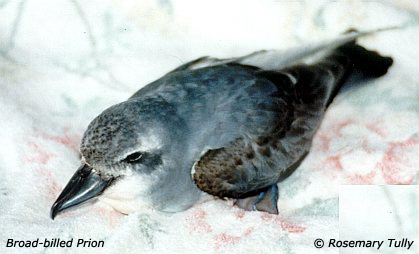- Broad-billed Prion
Taxobox
name = Broad-billed Prion
status = LC | status_system = IUCN3.1

regnum =Animal ia
phylum = Chordata
classis = Aves
ordo =Procellariiformes
familia =Procellariidae
genus = "Pachyptila "
species = "P. vittata"
binomial = "Pachyptila vittata"
binomial_authority = (Forster, 1777)The Broad-billed Prion, "Pachyptila vittata", is a smallseabird with grey upperparts plumage, a dark cap,a black "W" on the wings, a black tail tip, and white underparts. This is a large prion, 25–30 cm long, with a wingspan of 57–66 cm and weighing in average 160–235 grams. [Answer.com " [http://www.answers.com/topic/broad-billed-prion?cat=technology Broad-billed prion] "] It has a broad flat bill with comb-like fringes calledlamellae . The head pattern is more distinct and the tail band is less extensive than that of the similarFairy Prion .This species is found throughout oceans and coastal areas in the
Southern Hemisphere . Its colonies can be found onGough Island ,Marion Island , and on the sub-AntarcticAntipodes Islands off the coast ofNew Zealand .Its diet consists mainly of
plankton iccrustacean s, but, like other Antarctic prions, it uses its special bill to filter this food from the water. It feeds by running across the ocean surface with its bill open under water, moving its head from side to side and skimming forcopepod s and other small creatures, similar in principle to howbaleen whale s use their filter plates. The flight is heavier and slower than that of other prions. this species feeds in large flocks but does not follow ships.Breeding begins on the coastal slopes of the breeding islands in July or August. The parents incubate the egg for 50 days, and then spend another 50 days raising the chick. The main predators are
skua s, although on some islands, cats and rats have reduced this prion’s numbers drastically. Colonies disperse from December onwards, although some adults remain in the vicinity of the breeding islands and may visit their burrows in winter.References
* "Seabirds (Helm Field Guides)" 2nd edition, by Peter Harrison, 1991, Christopher Helm Publishers, ISBN 0-7136-3510-X
* [http://www.birdlife.org/datazone/species/index.html?action=SpcHTMDetails.asp&sid=3914&m=0 BirdLife Species Factsheet]
Wikimedia Foundation. 2010.
